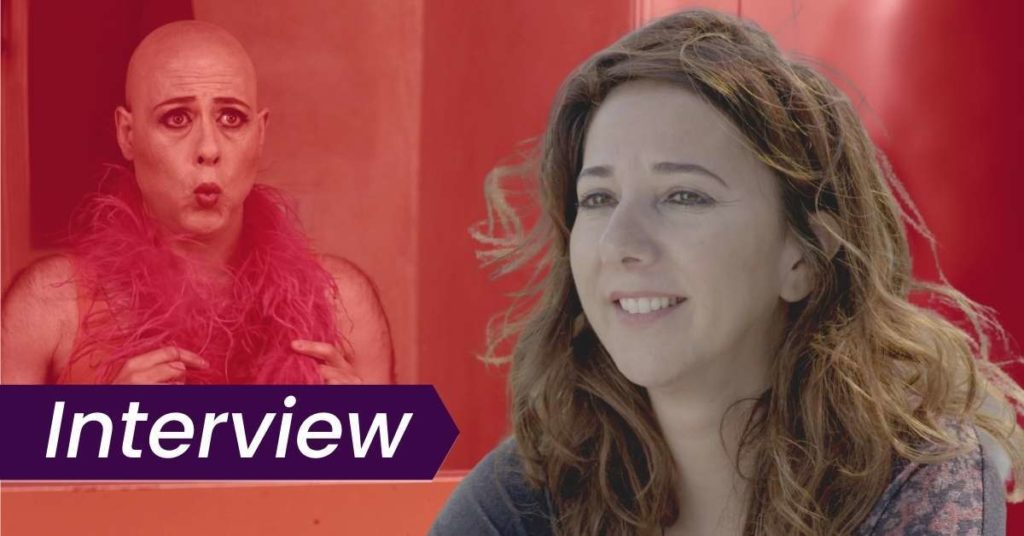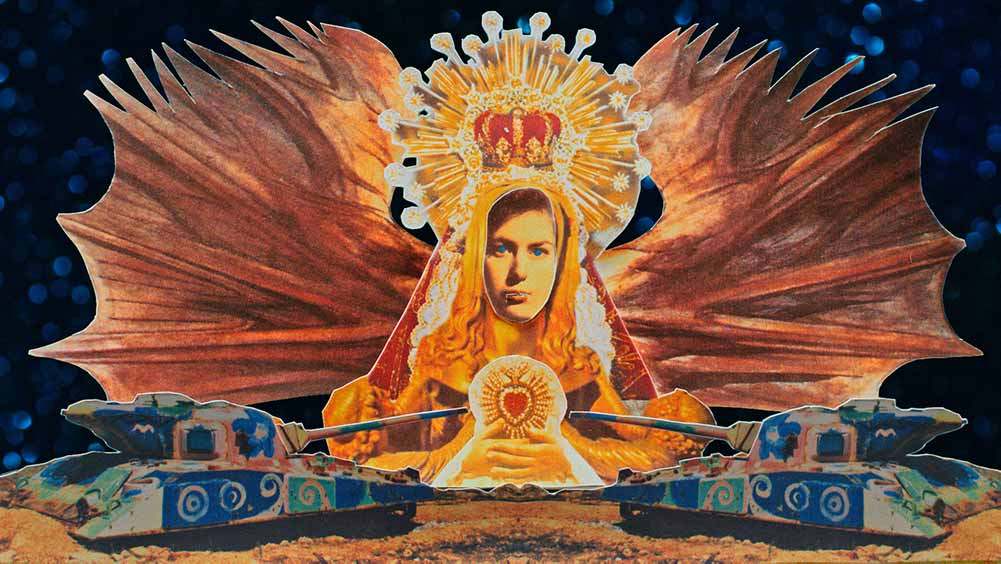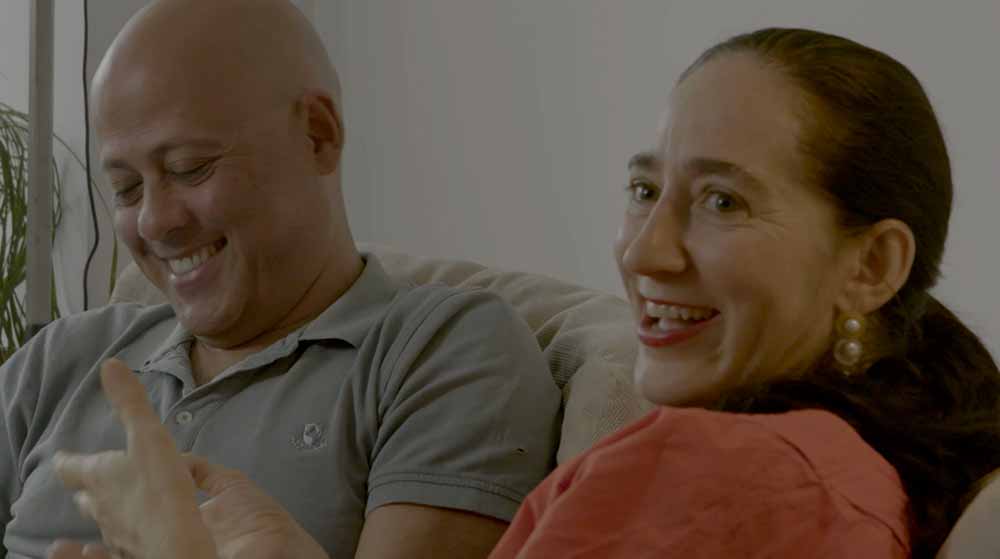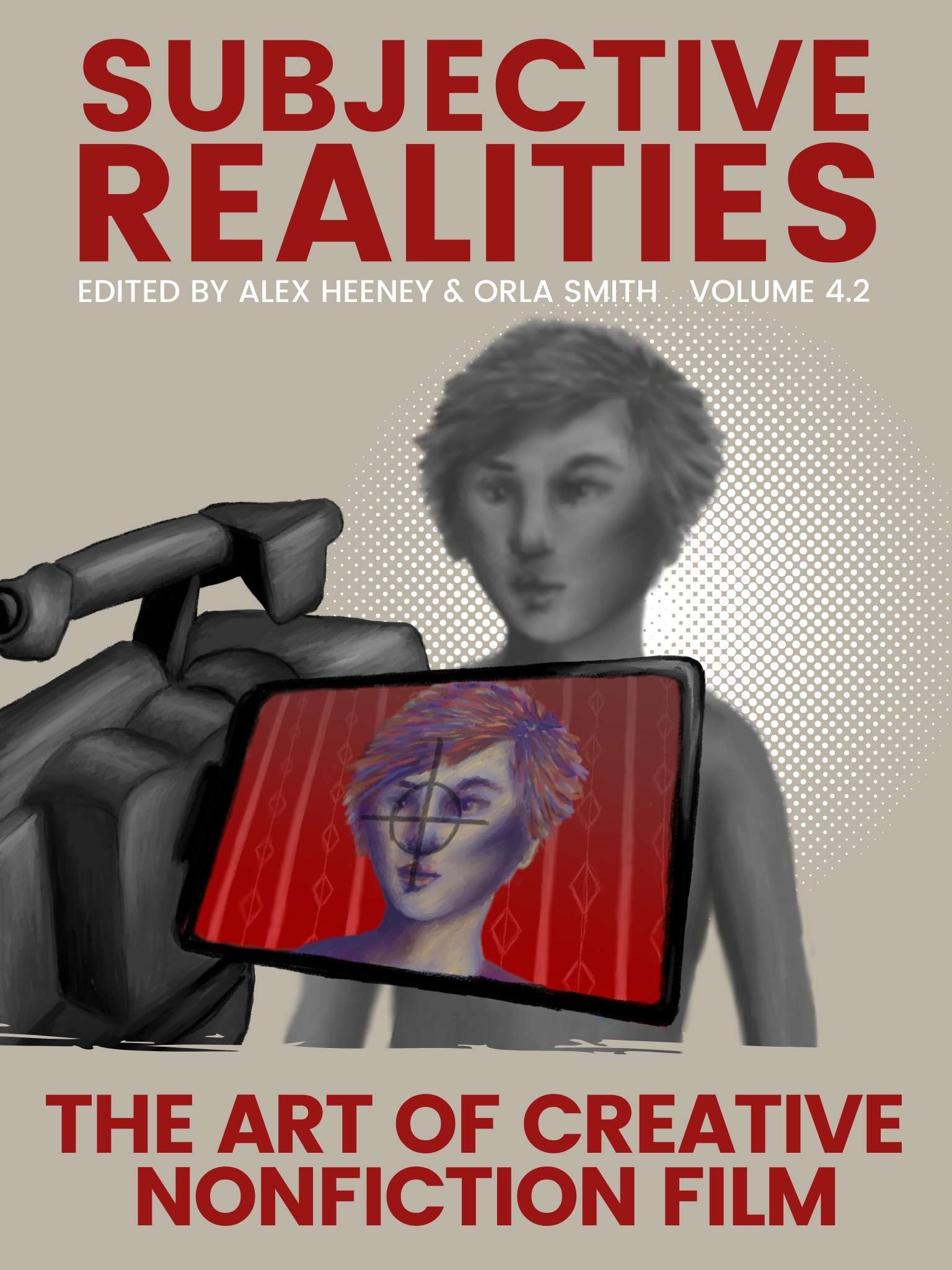Eliane Raheb discusses Miguel’s War and using creative documentary techniques to explore her subject’s life and trauma.
Check out all our Berlinale coverage.

Discover one film you didn’t know you needed:
Not in the zeitgeist. Not pushed by streamers.
But still easy to find — and worth sitting with.
And a guide to help you do just that.
I realised that Miguel’s War was going to be a boundary-pushing documentary as soon as the film’s subject, Miguel Alonso, responded to a probing question from director Eliane Raheb by laughing and exclaiming, “What a horrible bitch!” Raheb tells the story of Miguel, from his childhood in Lebanon, to his participation in the Lebanese Civil War, to his life in Spain, where he lives today, as an out gay man. But she’s just as interested in exhibiting the difficult process of getting Miguel to open up as she is recounting the facts of his life. This is a film about trauma — how it distorts and represses memory, and makes it hard to be honest with yourself and other people. For Raheb, it was just as important to include takes of Miguel (jokingly) calling her a bitch, declining to answer questions, and struggling to recall the truth than it was to include his eventual honest answers.
“I said from the beginning, it cannot be a film that would be edited in a normal way,” explained Raheb, who edited the film herself, as well as producing and directing it. “I have to reflect that we are friends, and he was afraid of me at certain times, and I was pissed off at him at certain times.” Raheb, who lives in Beirut, met Miguel when he was the interpreter for the Q&A of a Barcelona screening of her 2012 documentary, Sleepless Nights. That film also dealt with the residual trauma of the Lebanese Civil War, and it brought back memories for Miguel. “After [the Q&A], we went to a bar, and he vomited on me his story,” recalled Raheb. “I really say vomit, because he was talking, talking, talking for two hours.” In the years that followed, Raheb started working on the film, and she and Miguel became friends.
Raheb splits up Miguel’s War into four chapters: the first three are “Michel” (which was Miguel’s birth name and the one he used growing up in Lebanon), “Miguel” (the name he chose for himself when he moved to Madrid), and “Barcelona” (where Miguel eventually settled and built the life he leads today). The film is only vaguely, not strictly, chronological, often jumping back and forth between Lebanon and Spain, and past and present. As Raheb explained, “When [Miguel is] telling you his story, he doesn’t say it in a chronological way. He would say something and then something else, and then you are with him in Spain, but you feel that his emotions are in Beirut.” The first three chapters refer more to the different identities that Miguel has adopted in his life than they do to a place or a time. The fourth chapter, “Love, Only Love,” is where Raheb and Miguel look to the future, and attempt to find catharsis. As Raheb puts it, they are asking, “Can we find love, and what is love?”
Raheb “wanted to find a way [to tell the story] that really resembles Miguel: his baroque personality, his contradictions, and his multi-layered persona.” She achieves this by mixing a multitude of different creative techniques, forming a patchwork of a fractured life, rather than a crisp, linear story. Miguel’s memories are presented through 2D, collage-style animations, many of them colourful and bizarre, some of them mixed together with live-action footage. Raheb and Miguel also explore Miguel’s memories by auditioning actors to play people from Miguel’s past, from his mother, to Tony, an unrequited love of Miguel’s whom he fought alongside in the war. These actors play out scenes from Miguel’s past, and the camera captures him watching, or sometimes even playing a character in the scenes.
Raheb also includes herself on screen in the film, not just to illustrate her friendship with Miguel, but because, as she says, their stories share “patterns which we all live in Lebanon. It’s how family, religion, and politics mess with your life if you are not a conventional person and your identity is not a mainstream one.” Raheb’s own parents appear on screen in several scenes, and they even tell a personal story of their own: that of her father’s ex-lover, a Spanish woman called Paquita, whom Raheb and Miguel tried and failed to find in Spain. By including herself in the film and discussing her own feelings of otherness, Raheb highlights how Miguel’s story is not an anomaly. For Raheb, “It is a metaphor for the powers that rule us in that region [of the world]. It shows how they can mess up the identity of someone and make him become self-hating.”
Shortly after Miguel’s War premiered at the virtual Berlinale, I spoke to Raheb over Zoom, who was calling in from the mountains in Lebanon where she had retreated “to be in nature, because I was suffocating in Beirut, in the sound mix [wearing a] mask.” She had only locked picture on the film a week prior, and Miguel had just seen the finished version for the first time the day before. With the film fresh in her mind, Raheb discussed its origins, her various creative approaches, and how the filmmaking process was healing for Miguel.

Seventh Row (7R): Has Miguel seen the film?
Eliane Raheb: He saw it yesterday. I sent him a link. He saw it with some friends, because he was not happy knowing that people were watching it and that he wouldn’t be able to watch it. It was not in a screening room; it was just a big TV.
7R: What was that like? What did he say?
Eliane Raheb: He already saw a rough cut last year, and he liked the rough cut. He was really, really afraid about what the film would be before seeing the rough cut. But when he saw the rough cut, he told me, “It’s an honest film.” And yesterday, he assured me, “It’s an honest approach to my story.”
I think there are things he is maybe not realizing now, but will realize later, when the film will be watched by [more] people. They will interpret something which he was not aware of. It’s always like this when you make a film about a person and it goes to an audience. It’s not your story anymore. It’s your story plus the story of the person watching it.
7R: Could you tell me the story of how you and Miguel decided to make Miguel’s War?
Eliane Raheb: It was a very random encounter in Barcelona. I was showing a film of mine [Sleepless Nights], and he was the interpreter of the [Q&A]. That film I was showing was also about the confessions of somebody who was really, really involved in the war, in the militia. Miguel was watching the film, because he wanted to do the translation after, and at a certain point, he [left] the screening room. I was outside, because I don’t watch my films with people all the time. So I [asked] him, “Why are you out? Go in!” I pushed him inside.
After we started the [Q&A], I felt that he was not at ease. He was very emotional. Sometimes, he was sweating. I [wondered], why is this guy so emotional about the film? It was intriguing. After, we went to a bar, and he vomited on me his story. I really say vomit, because he was talking, talking, talking for two hours. I didn’t have any pencil to write; I was just listening. I was leaving the next day at night, so I [asked] him, “Can we meet again in the morning?” And he said yes. So he continued for another three hours, maybe.
When I went back [to Lebanon], I was on the plane, writing whatever he told me; I didn’t want to forget anything. It started to inhabit me, his story. I went back to Barcelona some months later, and I [conducted] a very long audio interview with him for nine hours, over three consecutive days. I was interrogating him. And then I told him, “I think this story is very good for a film.”
He did not believe that I wanted to make a story about him. [He asked,] “Why is it important?” I told him, it carries, for me, a lot of meaning. It is a metaphor for the three powers that rule us in that region [of the world]: family, religious institutions, and politics, which sometimes are led by the state or by militias. It shows how they can really mess up the identity of someone and make him become self-hating. He really hates himself and was unable to assert his own identity.
This is our main problem in that part of the world. We are still ruled by these three big powers. [Your are not able to] live your identity freely, [whether] it is sexual, or different from the mainstream, or if you are an introverted person, or if you are a weak person, or if you are not a conventional, mainstream, cliche of a [desirable] person. You always feel alienated and feel that you have a double life. You are something in front of your parents or [in front of] society, and then you are another person underground or in other countries.
I call this film a trip. A trip for him, of course, because we are confronting the ghost of his past, and we are trying to give a meaning to everything he did. And a trip for me, also, as a filmmaker, because I was trying to see, how will I tell this story? When he’s telling you his story, he doesn’t say it in a chronological way. It’s not like a chronological story that goes from A to B, and then you understand [him]. He would say something, and then something else, and then you are with him in Spain, but you feel that his emotions are in Beirut. He can live a situation that happened thirty-seven years ago like it’s happening now.
This was challenging for me. How will I tell this story? I wanted to find a way that really resembles Miguel: his baroque personality, his contradictions, and his multi-layered persona. This is why I’m mixing all these mediums together, because I thought that [I must use a] multi-layered form for such a complex story.
7R: Watching the film, I imagined it must have taken a long time to edit. You’re telling Miguel’s whole life story using many different creative techniques. How did you approach the structure of the film?
Eliane Raheb: I am the editor of the film. I have this material with Miguel which, of course, I have written before shooting many scenes. I did a [lot of] research, so I could expect what he would say in the moment. I knew how it would be. I felt that the text of the film was already done before shooting, because of those interviews I made. So how will I show it? And how will I bring the text into sync with the shooting and the scenes? That was quite challenging.
It was also [confusing] for Miguel if I am his friend, or if I am the filmmaker. I usually don’t become close to characters [as a] friend until the filming is over. It’s always very, very disturbing to manipulate images of your friends. Even if you are honest, you have the power. But I became friends with Miguel before the shooting and in the shooting. It was a long shoot, not in terms of days, but in terms of years, because we didn’t find the money in the beginning. So I was shooting parts and shooting parts, and then coming back and shooting. There was this relationship between us which [deepened].
I said from the beginning, it cannot be a film that would be edited in a normal way. I have to reflect, as much as possible, everything. I have to reflect that we are friends, and he was afraid of me at certain times, and I was pissed off at him at certain times. It has to reflect that. Things he told me in the [original audio] recording, [he told them differently] during the shooting. So I felt that no one can edit this film but me. I knew [the material] in my guts. I have to [make the film] as if I am making a dress, sewing it from the beginning to the end. And I have to [include] things which maybe are not necessary. An editor would say this is not necessary, but for me, it’s very important.
There is this American filmmaker who does documentaries, and he’s a film critic, as well. His name is Robert Greene. I saw his films in 2018. It was a revelation for me that you can put your character in every frame. I had to put Miguel in every frame, andI shouldn’t be afraid of that. [Greene’s films] gave me the confirmation that it would work.
We don’t care if he’s in Spain, or in Lebanon; the space is not important. It’s the emotional space that is important, not the physical space. I had in mind that it’s a novel, a documentary novel, in the sense that I can go from something to something else, just because there is a feeling that I want to do it. It’s not because it’s logical.
The editing took about one year and a half. I was trying things and then resting for some time to see them again, and to see if it works or not. Also, we had a revolution in Lebanon in 2019, and I was very involved. I was on the streets for three or four months; I didn’t touch the film, so I lost time. And in the pandemic, of course, I lost time. I was supposed to finish in spring 2019. I don’t see it as a problem, because it helped me to look at the material [with some distance] and to say, “I’m satisfied.”
The animation took a lot of time. Doing animation in a documentary is very tricky. You have to start with a draft: the animator would do some animatics, to see if it works. How do you get out of [the animated sequence]? How do you get into the animation?
I had hoped for a bigger budget, but it was not possible to have it. Producers and funders don’t like to take risks. This film was risky, really risky. Nobody understood what I was trying to do. (laughs) Unless they saw it completed.
Sometimes, they told me, “Well, we don’t like Miguel.” It was very weird, because I’m not doing a film because I want the people to like Miguel. We’re not a charity and I’m saving him. A part of [Miguel] is that you should not like him, because he did everything to construct a wall for people to not like him, almost on purpose. So this mixed feeling of the viewer — sometimes you would really like him, sometimes you would really hate him — if you meet the real Miguel, it’s like this. Mixed feelings. For me, it was a result of how these three powers make you somebody who doesn’t like yourself, who is unable to accept yourself, and who feels inferior and then suddenly feels superior.
I had to show this, and the funders didn’t give me the chance to do the film like I really wanted, with the means I wanted, like having a big team. I was paying for the animation from my own savings at the end. And I’m doing three jobs. It was painful in that sense. But I think that this also makes it special, because it’s an intimate film. You feel that it’s auteur-driven, because the director is involved in many things. It’s not like I executed the film, and then went away.
7R: Very quickly into watching the film, I really fell in love with Miguel. And then, as you said, the further into the film we get, you start challenging him, and his darker sides come to the surface. How did you think about the viewer’s relationship with Miguel and how that would change throughout the film?
Eliane Raheb: First of all, I usually think of a viewer as somebody who would participate in the film experience. I don’t like passive viewers. I don’t like to give them everything and make them happy in their comfortable seats. They will see a miserable story and then go home as if they didn’t see anything and feel that they are very nice and very good, because in that part of the world, people are miserable. I really hate all these miserable feelings. That makes the spectator feel, “Oh, I have compassion.” I don’t like compassion. And I don’t like passivity.
I like spectators who question themselves when they watch the film. They are confused if they should like him or not. I like all this, because I think life is like this. So I didn’t think of the spectator. After, when I was editing the film, I felt that I wanted to be honest to the process. Whatever I felt at that moment, with Miguel, I tried to put it [in the film]. If I was confused or angry, or I feel he’s lying, or I want to hug him, I felt that I have to [put this in the film]. The viewer, maybe will feel the same.
7R: Why did you decide that you wanted animated scenes in the film?
Eliane Raheb: From the beginning, I knew that I would use animation, because I felt that one of the layers of Miguel is a layer of the fantasy, taboo, nightmares, and dreams. This would be difficult [to convey through live action]. I don’t want him only to talk, talk, talk in the film. I want to show what’s in his head. I felt that the best way to portray this layer of baroque fantasy would be through animation.
The budget did not allow us to shoot more in Spain. So the parts of his life [as an out gay man], as he lived it, in a very debaucherous way, I didn’t find the images for it. I had to use this animation to show this extravagant life he had in the ‘80s in Spain. This was not planned.
And why this 2D, stop-motion collage? It’s because I felt that this is the closest style that would resemble somebody trying to bring back memory. When you try to remember things, you remember them fragmented. You remember something from here and something from there.
7R: Why did you include the audition scenes in the film, where you and Miguel cast actors to play people from his past? I’ve seen a similar casting conceit before, but never in this way.
Eliane Raheb: The people from his past don’t exist anymore. I just found Tony [an unrequited love of Miguel’s whom he fought alongside in the war]. All the rest, they don’t exist. Either they’re dead, or they are like ghosts. I don’t know what happened to them.
It’s not important to find the best actor for that role, because I’m not doing a fiction film. I would cast many people, and I would take from everyone something that would resemble Miguel’s [past]. Some of those people we cast would turn into animation. I did not want them to turn into fiction reenactment, like, “We are now in a fiction [film].” They would turn into animated persons or just impressions of characters.
It was funny to see Miguel interacting [with the actors], because he is a person who likes to perform, but he did not become a performer. It was a way for me to see him trying to act, the same way he did when he told me his story [when we first met] in Barcelona.
The people [in the auditions] did not know who this guy [Miguel] was. They were confused, like, “Who is this guy, and who is the director? Is she or he the director? And why is he coming to the stage?” So it created a reality of confusion, of [questioning], is this fake? Is it true?
Sometimes, there are sad parts, and very violent parts, but I also wanted the film to be entertaining. Miguel is an entertaining person. He can cry and laugh at the same time. He could think, “I am miserable; I had a miserable life,” and cry, but he did not. It was a way for him to survive, to be laughing and to be entertaining.
I wanted the film to be entertaining, because I hate misery in films, where we are talking about a miserable thing and we are choosing to make the spectator feel miserable. I don’t like this. I like to at least be funny and entertaining.

7R: What did you put in the casting brief to find those actors? How much did you tell them about the project?
Eliane Raheb: Nothing.
7R: What did they think they were auditioning for?
Eliane Raheb: They would sometimes discover very, very [limited pieces of information, like], I’m searching for fighters, or for boys who are thirty-five years old and who are willing to play a tough man. Even the ladies, they knew afterwards that they were trying to play [Miguel’s] mother.
Even my mother, when she came to the casting, she didn’t understand what she was coming for. But she was very happy!
7R: How did you decide to put your mother in the film?
Eliane Raheb: I always felt a connection [between my story and Miguel’s]. With Miguel, I really went to search for Paquita [a Spanish woman who is Raheb’s father’s ex-lover]. [Early in the process], we went to Madrid, and we went to search for Paquita. So that became part of that story, as well, as we did not find her. Of course, during our search, he would tell me other stories. His story and my story became linked.
When I was shooting in Lebanon the second time, I became aware that this film is very personal for me. I wanted to shoot that link. And I would see in the editing, if I would use it or not. I was aware that maybe I will throw this [out] in the editing. I found that it was funny and nice to put it in the film.
It was also an honest way to expose a part of myself. I’m sure that the spectator in the beginning thinks, “Why is this filmmaker so involved in the film? It’s not about her! Why is she fighting with him? Why is she sometimes aggressive?” They will not feel at ease with me. At the end, they will think, “Ah, okay, we now know that she has — not a similar story, because the story is extreme, but patterns which we all live in Lebanon.”
It’s how family, religion, and politics mess with your life if you are not a conventional person and your identity is not a mainstream one. In that sense, I feel queer. Queer is not sexual only for me. Queer is political: when you do not fit in all the stereotypes and all the mainstream identities that everyone prays for. I wanted the Miguel story to mirror queer identity in a big, wide sense. This is why also putting my story in the film, even if it’s a little part, makes me and him alike, even if, sometimes, I was aggressive [toward] him. He is my ally. We are alike, and we were doing this together. I was violent with him because I am also a product of the Civil War. I am a product of that violence. So it’s in my personality, and I will not hide it.
7R: There are a lot of moments in the film that you keep in that are usually cut out of documentaries, like asking Miguel for consent to shoot, asking him what questions you can and can’t ask, and the moments in the film when he calls cut. You reveal the process of making the film within the film itself. Why was that important for you to do?
Eliane Raheb: Because that was part of the process. There’s nothing called truth in documentaries. It’s a big lie to say documentary is truth. And it’s a big lie for me to put the narration of Miguel from the beginning to the end as a voiceover just to make it flow. I wanted to show the fragility of doing a film with somebody who is controversial, who had traumas, and who cannot tell his story in an easy way. I wanted to show this, and I wanted to be honest with the process itself. This is why I left in all these parts of filmmaking, of the team, of him not able to continue, and involving him in the filmmaking itself.
Usually, it’s a director who says cut; it’s not the character who says cut. But I’m giving him the power to say cut when he does not feel that he wants to continue. I wanted to involve him in that process of telling his story. I feel that it’s really a film for him, also. This is why, at the end, I ask him [on camera], where do you think this film should end?
7R: There are four title cards in the film that break it up: “Michel”, “Miguel”, “Barcelona”, and “Love, Only Love”. How did you decide on that four-part structure?
Eliane Raheb: It’s a part of what I was telling you, that [the film] feels like a novel. So it needed chapters. Even if, inside the chapters, we are not just talking about [just] one thing or one theme. It’s a chapter for an identity, like the identity of Michel and the identity of Miguel. And the third one, the identity of Barcelona, because I feel that Miguel has three identities: the identity of the traumatized in Lebanon; the identity of Miguel Alonzo, who became totally libertine, doing all the craziest things he had not done in Lebanon; and then Miguel in Barcelona today, who’s trying to rebuild himself. He is aging, and he is trying to deal with existential questions.
This fourth part was about love. Can we find love, and what is love? So [finishing off] everything we built in the film, which has to do with love: love of the parents, love of Tony, the ultimate love, the big love, does it exist or not? And the church. [In the scenes in the church in chapter four], I give him the power to be the guy whose feet we kiss [when his feet are literally kissed in the church]. It’s not the opposite. He’s not the humiliated one. I give him his pride again, in the place that told him that he was the wrong person, a guy who had the devil in his soul.
We did not have the chance, in Lebanon, to be spiritual. The religious institutions kill your spirituality and make you afraid of religion or just to use it for political things. So we tend to lose spirituality. I think that Miguel is a spiritual person, although he denied it. He had this big wound because of the church. I wanted to also give him this key, that maybe he should reconcile with his spirituality.
7R: What are you working on next?
Eliane Raheb: I don’t know. I just finished, and I am happy that I finished. It was really a long journey, so now I’m just drained. I just finished the film and uploaded it three days before the festival. I applied with a work in progress, and when I knew that I was accepted, I did the last sprint.
Now, I just came to the mountains to be in nature, because I was suffocating in Beirut, in the sound mix with the mask. I was really intoxicated for the last two weeks. I was wearing masks in the studio for hours and hours, it was really traumatizing for me, more than the civil war. (laughs) Well, no, no.
7R: Now that you mention it, I would like to ask about sound. What was your approach to the sound design?
Eliane Raheb: I wanted to have a very colourful film, not only in the image, but also in the sound. There are the songs that Miguel sings, which are opera. And there is the sound that comes from the street. And there is the animation sound design, which are experimental sounds. It’s sounds which are weird and would make you enter into a weird world.
There is the Arabic song, “I Love the Sea” (“Ana Be’shak al Bahr”) that I put in the film whenever I [wanted to show] love, or to tell Miguel that I love him. Whenever I felt that I was really tough on him, I wanted him to understand that I love him, even if I was tough. And the viewer would feel something nice at this moment, of this fragile lady singing a song for the sea.
In the beginning [of the film], there’s lots of sounds, but it becomes much more simple, towards the end. It becomes much more basic sound[-wise] because as Maria, [Miguel’s] friend [who appears in the film], describes him, he was restless. He couldn’t bear being lonely or alone, or just hearing himself. He always wanted to be surrounded by sounds, just to feel that he’s not alone. In the end, I think the film shows that he’s becoming more calm. The sound becomes much more disciplined, more basic, and less complicated than the beginning.
7R: Do you think that the process of making the film was therapeutic for him? Do you think it’s changed the way he thinks about his life?
Eliane Raheb: Yeah, I think that it was a catharsis for him. I mean, he said it, it’s not like [only] I am saying it. As a filmmaker, I try to create the space for catharsis.
I know that, from the time I met Miguel in 2014 to today, he changed a lot. He’s less impulsive. I think he’s reconciling with everything and trying to find meaning for what he did. He’s accepting himself, accepting his roots, and accepting that he might find something nicer in the future.
You could be missing out on opportunities to watch great films like Miguel’s War at virtual cinemas, VOD, and festivals.
Subscribe to the Seventh Row newsletter to stay in the know.
Subscribers to our newsletter get an email every Friday which details great new streaming options in Canada, the US, and the UK.
Click here to subscribe to the Seventh Row newsletter.


